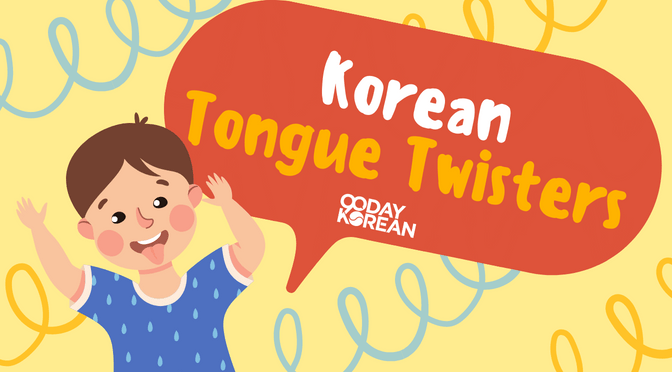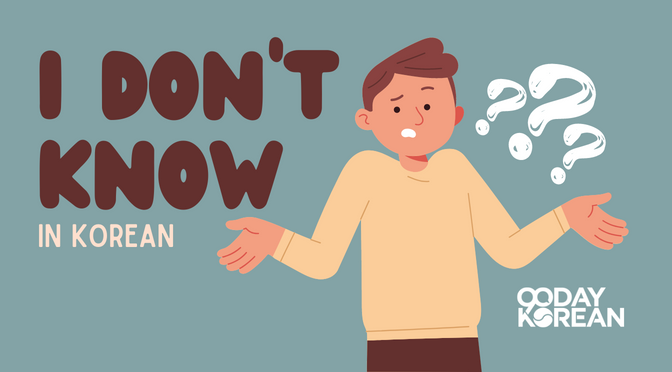Do you know any Korean tongue twisters? How about English ones? What’s your favorite one to say? Learning these is a fun way to pass the time, loosen up, and simply practice speaking.
For example, you improve your pronunciation through tongue twisters, and it’s a fun way to do so, too, as you won’t get discouraged or upset no matter how many times you mess up with the phrase.
The tongue twister about Peter Piper is a great example of a popular English tongue twister. But what kind of tongue twisters can you find in the Korean language? Let’s learn some Korean and check out some fun tongue twisters in South Korea!
Contents
What are Korean tongue twisters?
As is perhaps the case in your native language as well, Korean tongue twisters are short or long sentences that combine words that tend to get your tongue twisted, so to speak, especially when trying to say them fast or repeat the sentence multiple times in a row.
And just like in other languages, the purpose of a tongue twister in the Korean language is to evoke laughter and fun by continuously messing up the sentences. And trust us, even the wittiest of us can get them wrong often enough!
How are tongue twisters helpful in practicing Korean?
As was mentioned above, these tongue exercises can be a helpful tool for practicing Korean. Here are ways you can utilize this resource.
Improves your Korean pronunciation
For starters, it will do wonders with how you pronounce Korean words. Even if, at a glance, a Korean tongue twister doesn’t sound like one, once you get to try to pronounce it, you’ll realize exactly why it’s one.
Thus, even if you mess up multiple times or have to take it slow, tongue twisters are great practice for understanding how the Korean language rolls off your tongue and the shapes your mouth forms when speaking in Korean.
Be familiar with different Korean sounds
In fact, when it comes to training your mouth and especially your tongue to get accustomed to the specific sound sets of Korean – or any other language – tongue twisters are an amazing tool to use.
In other words, you are training your tongue to use in the specific ways it does in Korean, but it might not be in your native one. Of course, speaking out loud in any sentence and phrase is helpful, but the repetition present in tongue twisters elevates the level of helpfulness.
It can be used to practice writing and learn new vocabulary
Writing these down can also help you familiarize yourself with the Korean writing system. As you practice reading them, take some time also to write down each Korean word that you encounter.
And because you’ll be repeating those words again and again, not to mention in an intriguing context, it’s highly unlikely you’ll ever forget them! They can also work wonders in understanding how Korean grammar works.
How to practice pronunciation with tongue twisters?
First of all, do not fear to start slow. While the fun in tongue twisters may lie in trying to repeat them as quickly as possible, you don’t have to try – nor should you – match the speed of a native speaker the first time you try.
Instead, you’ll initially want to focus on clearly pronouncing each word and get a proper feel of how they roll off your tongue. And then, the more you practice, the quicker you can say them. However, speed isn’t what you should prioritize until you’ve gained the confidence that you can pronounce the words right.
Can you also use tongue twisters as listening practice?
As briefly mentioned above, these can also help you become more familiar with different Korean sounds. Besides being a wonderful tool for practicing speaking and pronunciation, Korean tongue twisters can be helpful for your Korean listening comprehension as well.
In this case, they can get your ears more used to hearing Korean and the sounds that Korean makes. In turn, it will become easier for you to dissect what you hear when Korean is being spoken around you. It may sound silly, as you are essentially only listening to yourself.
However, as you are listening to yourself speak out these tongue tricks, you are also paying attention to your own pronunciation. And, when needed, will make adjustments to get the pronunciation right. By needing your listening skills to perfect your pronunciation, you are, in turn, also honing those listening skills themselves.
And because Korean tongue twisters involve words that are incredibly similar to each other, it is indeed putting your listening skills to the test. You need to be careful, both listening and speaking, to be able to spot the small differences between words and get them right.
Korean Tongue Twister List
Below you can find a few examples of the famous Korean tongue twisters in Hangeul (Korean alphabet), with romanization and the meaning. These can be great ones to start practicing different tongue twisters with. If you don’t know how to read in Hangeul yet, we suggest learning it first, as it will be helpful in the long run!
#1. 간장 공장 공장장은 장 공장장이고 된장 공장 공장장은 강 공장장이다.
(ganjang gongjang gongjangjangeun jang gongjangjangigo dwenjang gongjang gongjangjangeun gang gongjangjangida.)
The soy sauce factory manager is Factory Manager Jang, and the bean paste factory manager is Factory Manager Kang.
#2. 육통 통장 적금 통장은 황색 적금 통장이고 팔통 통장 적금 통장은 녹색 적금 통장이다.
(yuktong tongjang jokkkeum tongjangeun hwangsaek jokkkeum tongjangigo paltong tongjang jokkkeum tongjangeun nokssaek jokkkeum tongjangida.)
Six dong bank book savings book is the yellow bank savings book, and eight dong bank book savings book is the green bank savings book.
#3. 네가 그린 기린 그림은 못 그린 기린 그림이고 내가 그린 기린 그림은 잘 그린 기린 그림이다.
(nega geurin gi rin geu ri meun mot geu rin girin geurimigo naega geurin girin geurimeun jal geurin girin geurimida.)
Your giraffe painting is a poorly drawn drawing of a giraffe, and my giraffe painting is a well-drawn giraffe painting.
#4. 서울특별시 특허허가과 허가과장 허과장.
(seoulteukbyeolsi teukheoheogagwa heogagwajang heogwajang.)
Patent granting section permission section chief of Seoul Metropolitan City, Chief Heo.
#5. 저분은 백 법학박사이고 이분은 박 법학박사이다.
(jeobuneun baek beopakbaksaigo ibuneun bak beopakbaksaida.)
That is Mr. Baek, a doctor of law. This is Mr. Park, also a doctor of law.
#6. 경찰청 철창살은 외철창살이고 검찰청 철창살은 쌍철창살이다.
(gyeong chal cheong cheol chang sareun oecheolchangsarigo geomchal cheong cheol chang sa reun ssangcheolchangsarida.)
The iron bar windows of the police headquarters are single-layer iron bars, and the iron bar windows of the prosecutor’s office are double-layer iron bars.
#7. 고려고 교복은 고급 교복이고 고려고 교복은 고급 원단을 사용했다.
(goryeogo gyobogeun gogeup gyobogigo goryeogo gyobogeun gogeup wondaneul sayonghaetda.)
Gohryeogo uniforms are high-quality uniforms, and Gohryeogo uniforms are high-quality materials.
#8. 목동 로얄 뉴로얄 레스토랑 뉴메뉴 미트소시지소스스파게티 크림소시지소스스테이크.
(mokdong royal nyuroyal reseutorang nyumenyu miteusosijisoseuseupageti keurimsosijisoseuseuteikeu.)
Mokdong Royal New Royal Restaurant new menu, meat sausage sauce spaghetti, cream sausage sauce steak.
Vocabulary words used in the Korean tongue twister examples
Now, you can find some of the vocabulary used in the tongue twisters above.
| Korean | English |
|---|---|
| 간장 (ganjang) | soy sauce |
| 공장 (gongjang) | factory |
| 공장장 (gongjangjang) | factory manager |
| 장 (jang) | manager |
| 된장 (dwenjang) | soy bean paste |
| 육 (yuk) | six |
| 통장 (tongjang) | bank passbook |
| 적금 (jeokgeum) | installments savings |
| 황색 (hwangsaek) | yellow |
| 팔 (pal) | eight |
| 녹색 (noksaek) | green |
| 기린 (girin) | giraffe |
| 그림 (geurim) | drawing, painting |
| 특별시 (teulbyeolsi) | metropolitan city |
| 특허 (teukheo) | patent |
| 허가 (heoga) | permission |
| 과장 (gwajang) | department chief, section chief |
| 법학박사 (beopakbaksa) | doctor of law |
| 경찰청 (gyeongchalcheong) | police headquarters |
| 철창살 (cheolchangsal) | iron bar windows |
| 검찰청 (geomchalcheong) | prosecutor’s office |
| 교복 (gyobok) | uniform |
| 고급 (gogeup) | high-quality |
| 레스토랑 (reseutorang) | restaurant |
| 메뉴 (menyu) | menu |
If you’d like to learn more similar vocabulary above, here’s a list of resources you can read.
- Korean Numbers – Step-by-Step Guide for Counting in Hangul
- Colors in Korean: Complete list with audio and usage examples
- Animals in Korean – Vocabulary for Pets and Wildlife Creatures
- Jobs in Korean – Complete List of Occupations and Titles
- Cook in Korean – Useful words and vocabulary for the kitchen
- Bank in Korean – Money and Finance Vocabulary
Wrap Up
What are your favorite Korean tongue twisters among the ones presented? What is your favorite tongue twister in your native language? And do you typically find tongue twisters tough but fun? Leave us a comment below if your tongue also got all twisted up reading these out loud – they sure got ours twisted!
Next up, maybe you’d like to learn more tricks for how to read Korean faster!





